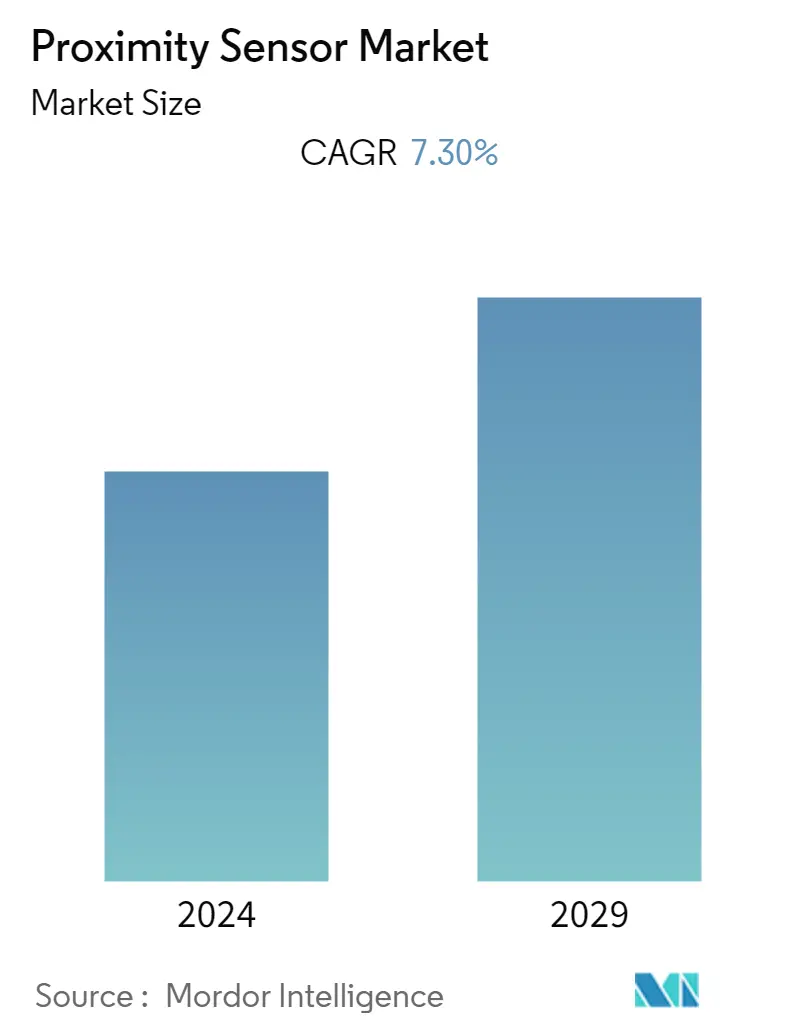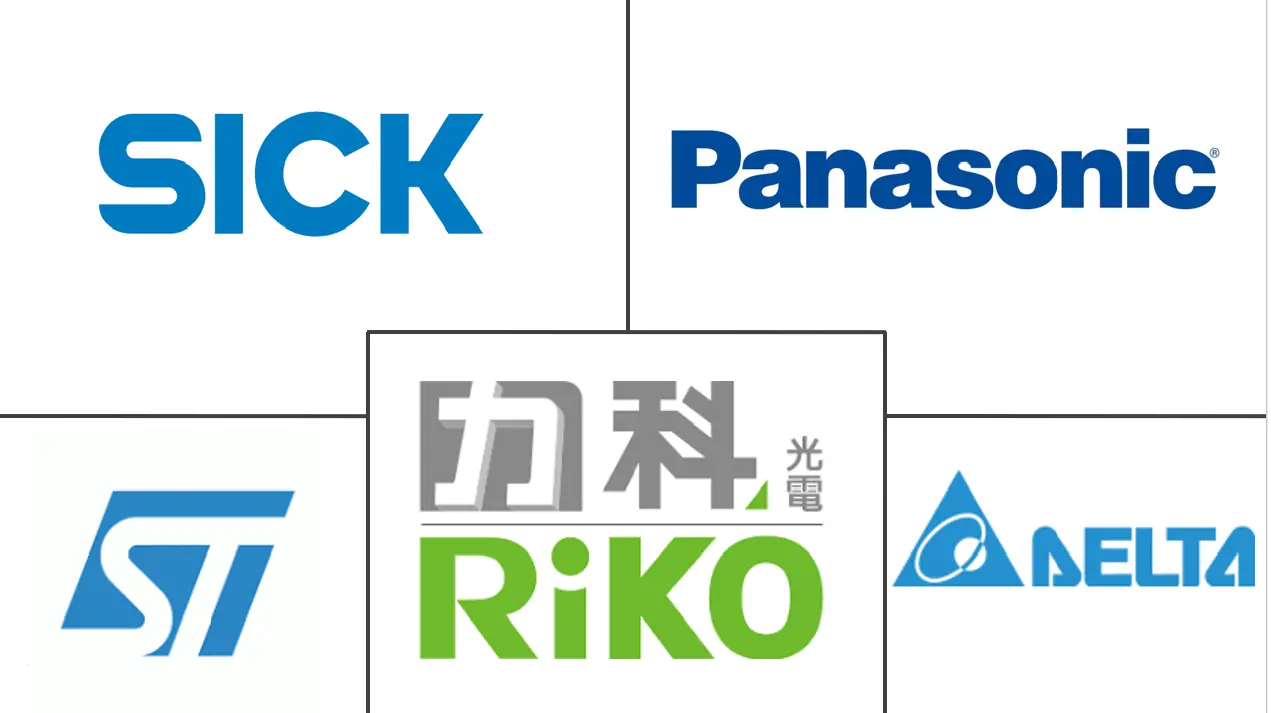Market Size of Proximity Sensor Industry

| Study Period | 2019 - 2029 |
| Base Year For Estimation | 2023 |
| CAGR | 7.30 % |
| Fastest Growing Market | Asia Pacific |
| Largest Market | North America |
| Market Concentration | Low |
Major Players
*Disclaimer: Major Players sorted in no particular order |
Proximity Sensor Market Analysis
The Proximity Sensor Market was valued at USD 3790.5 million in 2020 and is expected to reach USD 5761.12 million by 2026 and grow at a CAGR of 7.3% over the forecast period (2021 - 2026). The proximity sensor can detect the presence of objects within its vicinity without any physical contact. For sensing objects, this sensor radiates or emits a beam of electromagnetic radiation, usually in the form of infrared light, and detects the reflection to determine the object's proximity or distance from the sensor.
- However, the shut down of manufacturing facilities in various countires like China, many parts of the world experinced shortage in supply of the component throughout February and March of 2020 owing to the global COVID-19 pandemic. Moreover, many companies started utilizing technology to contain the spread of the coronavirus and thus are developing various electronic devices.
- The growing industrial automation has been emerging to be a relatively more attractive space for investment by organizations across the world. The dependence on robots in industrial controller mechanisms is an established trend, paving the way for more extensive and wider adoption of the industrial control and automation equipment.
- The rise in automation of complex production systems has increased the demand for components capable of providing critical data related to the production process. These sensors facilitate process control in factories by detecting the presence and position of metal objects. Proximity sensors can also help in automating procedures and even repetitive tasks, resulting in an efficient production line.
- The technology complexity can be reduced to an extent with the implementation of non-contact sensing technology. This is the primary reason for the increasing demand for sensing components, like a proximity sensor.
- However, limitations in sensing capabilities and availability of other sensors at a lower cost may hinder the growth of the proximity sensor market.
Proximity Sensor Industry Segmentation
A proximity sensor is a sensor that is able to detect the presence of nearby objects without any physical contact. A proximity sensor often emits an electromagnetic field or a beam of electromagnetic radiation (for instance, infrared) and detects changes in the field or return signal. The study considers only B2B facet of proximity sensors usage and not B2C.
Although the usage is not significant in some of the end-user industries, such as food industry, it is expected to be compensated by usage in automotive and defense applications. The non-contact sensing factor increased the number of applications of the sensors. The scope of the study for the proximity sensor market is limited to the type of technology principles of the sensors and their respective applications in a wide range of end-user industries, globally.
| By Technolgy | |
| Inductive | |
| Capacitive | |
| Photoelectric | |
| Magnetic |
| By End-user Industry | |
| Aerospace and Defense | |
| Automotive | |
| Industrial | |
| Consumer Electronics | |
| Food and Beverage | |
| Other End-user Industries |
| Geography | ||||||
| ||||||
| ||||||
| ||||||
| Rest of the World |
Proximity Sensor Market Size Summary
The proximity sensor market is experiencing significant growth, driven by the increasing demand for automation and the adoption of non-contact sensing technologies across various industries. Proximity sensors, which detect the presence of objects without physical contact by emitting electromagnetic radiation, are becoming essential in industrial automation, automotive applications, and consumer electronics. The rise in industrial automation has led to a greater need for sensors that provide critical data for process control, enhancing efficiency in production lines. In the automotive sector, the demand for touch-free user interfaces in systems such as keyless entry and parking assistance is propelling the adoption of proximity sensors. Additionally, the growing popularity of smartphones and the need for advanced features like in-display sensors are contributing to market expansion.
Despite the positive growth trajectory, the proximity sensor market faces challenges such as limitations in sensing capabilities and competition from lower-cost alternatives. The market is characterized by intense competition, with numerous players developing innovative solutions and strategic partnerships to enhance their offerings. Regions like the United States are leading the market due to their advanced technology infrastructure and high demand for smart parking solutions. The presence of major technology companies and the increasing awareness of modern traffic control solutions further bolster the market's growth in these areas. As the market continues to evolve, collaborations and technological advancements are expected to play a crucial role in shaping its future.
Proximity Sensor Market Size - Table of Contents
-
1. MARKET DYNAMICS
-
1.1 Market Overview
-
1.2 Industry Attractiveness - Porter's Five Forces Analysis
-
1.2.1 Threat of New Entrants
-
1.2.2 Bargaining Power of Buyers/Consumers
-
1.2.3 Bargaining Power of Suppliers
-
1.2.4 Threat of Substitute Products
-
1.2.5 Intensity of Competitive Rivalry
-
-
1.3 Industry Value Chain Analysis
-
1.4 Market Drivers
-
1.4.1 Increase in Demand for Non-contact Sensing Technology
-
1.4.2 Growth in Industrial Automation
-
-
1.5 Market Restraints
-
1.5.1 Limitations in Sensing Capabilities
-
-
1.6 Impact of Covid-19 on the Market
-
-
2. MARKET SEGMENTATION
-
2.1 By Technolgy
-
2.1.1 Inductive
-
2.1.2 Capacitive
-
2.1.3 Photoelectric
-
2.1.4 Magnetic
-
-
2.2 By End-user Industry
-
2.2.1 Aerospace and Defense
-
2.2.2 Automotive
-
2.2.3 Industrial
-
2.2.4 Consumer Electronics
-
2.2.5 Food and Beverage
-
2.2.6 Other End-user Industries
-
-
2.3 Geography
-
2.3.1 North America
-
2.3.1.1 United States
-
2.3.1.2 Canada
-
2.3.1.3 Mexico
-
-
2.3.2 Europe
-
2.3.2.1 United Kingdom
-
2.3.2.2 Germany
-
2.3.2.3 France
-
2.3.2.4 Rest of Europe
-
-
2.3.3 Asia Pacific
-
2.3.3.1 China
-
2.3.3.2 Japan
-
2.3.3.3 South Korea
-
2.3.3.4 Rest of Asia Pacific
-
-
2.3.4 Rest of the World
-
-
Proximity Sensor Market Size FAQs
What is the current Proximity Sensor Market size?
The Proximity Sensor Market is projected to register a CAGR of 7.30% during the forecast period (2024-2029)
Who are the key players in Proximity Sensor Market?
Panasonic Corporation, Riko Opto-electronics Technology Co. Ltd, SICK AG, STMicroelectronics NV and Delta Electronics Inc. are the major companies operating in the Proximity Sensor Market.

